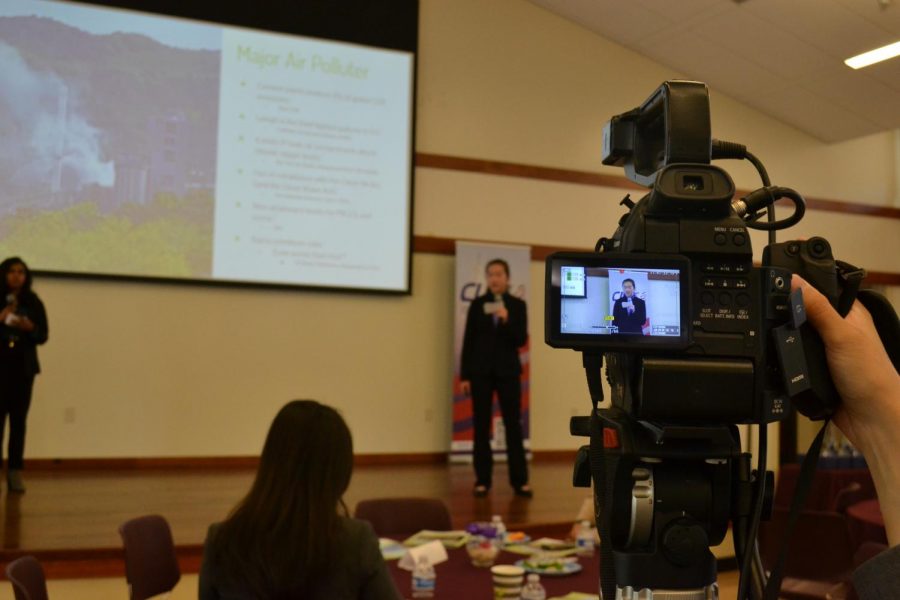Lehigh Cement Company’s pollution issue
MVHS students spoke against Lehigh Cement Company’s harmful emissions to nearby residents at a Youth In Action (YIA) Conference
November 24, 2019
On Nov. 9, 2019, the Youth In Action (YIA) conference was held at the Orchard City Banquet Hall. Students spoke about various topics such as air pollution, housing crisis and teen mental health. A group of MVHS students from an organization called Young American Policy Advocates (YAPA), including sophomores Anita Chamraj and Rachel Chen, spoke at the conference to bring awareness to Lehigh Cement Company’s harmful emissions. Lehigh Hanson Cement Plant, owned by Hanson Permanente Cement, has been a longtime producer of Silicon Valley building materials.
“Since the factory is really old, they don’t have that many techniques or methods or engineering to reduce their pollution,” Chen said. “Though they said in the Reclamation Act that they would have restoration after they finish mining, their efforts so far have been minimal.”
In December of 2011, the Sierra Club filed a lawsuit against Lehigh Cement which charged a $7.5 million fine to settle water pollution violations. The plant was found to be leaking millions of gallons of toxic wastewater into Stevens Creek, wastewater that contained levels of selenium — an extremely toxic element to wildlife organisms — surpassing the safety level by several folds. After several tests, the Sierra Club found the plant in violation of the Clean Water Act and discovered Lehigh’s pollution to be possibly compromising San Francisco Bay’s water quality as well.
Chen believes that by spreading awareness through presentations such as her YAPA research, public pressure can influence this major polluter towards compliance.
“Basically, we presented some background information about Lehigh,” Chamraj said. “And then we presented the major problems and how [Lehigh is] a big polluter and how they plan to expand and continue mining for at least 15 more years. And then we … also [presented] our solutions, and how we believe that Lehigh should be stopping [and] the city and Ro Khanna should take action.”
Owned by the Heidelberg Cement Group of Germany, the Lehigh Quarry Cement Plant, located off of Stevens Creek Blvd, is one of the closest industrial locations to residential areas. Because the facility isn’t located in city borders, the City of Cupertino is not able to enforce any environmental restrictions.
The YAPA group’s research focuses on several different types of Lehigh emissions, including water pollution, since the water that the cement plant contaminates eventually leads into the Stevens Creek, which then leads to the SF Bay.
The group also discovered that officials found a pile of waste, originally planned to be placed in the west storage unit of the factory, to be excessively toxic — too toxic for the storage area. Because of this, the factory decided to leave the waste in the open, subsequently making it easier for toxins to leak into the surrounding environment.
The YAPA group’s mentor, Rhoda Fry, played a major role in aiding the YAPA students in their research. She became involved with the Lehigh issue in 2010, when the city confirmed that the Bay Area Air Quality Management District had been under-reporting mercury pollution from the cement plant.
Fry believes that the significance of the quarry issue lies not only in the consistent air pollution, but also in city officials’ inability to take major action against the problem. According to Fry, Lehigh is the top stationary source of greenhouse gasses in the Santa Clara County, and is the third highest sulfur polluter in the state of California.
“Unfortunately, the regulatory agencies such as the Bay Area Air Quality Management District, Water Boards and County have been slow to regulate,” Fry said. “Only public pressure, including a lawsuit from the Sierra Club, has inched this major polluter toward compliance.”
Among other projects, Fry says that Lehigh plans to expand its quarry, lowering the scenic ridgeline of Rancho San Antonio, and plans to build a new quarry above the Stevens Creek Reservoir. This project fails to adhere to their 2012 plan of closing the quarry.
“Quarrying creates air, water, traffic and noise pollution, impacts our viewshed and extends the life of the antiquated cement plant,” Fry said. “Additionally, in order to protect the aquifer, the quarry pit needs to be filled when quarrying is complete. Instead of filling the quarry as planned using onsite quarry waste, Lehigh intends to erect an unsightly mountain of quarry waste and import 666 truckloads of construction waste to the site per year for 33 years.”















